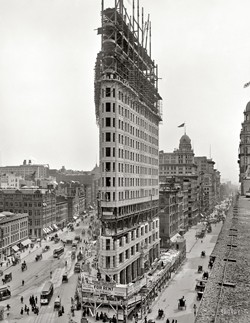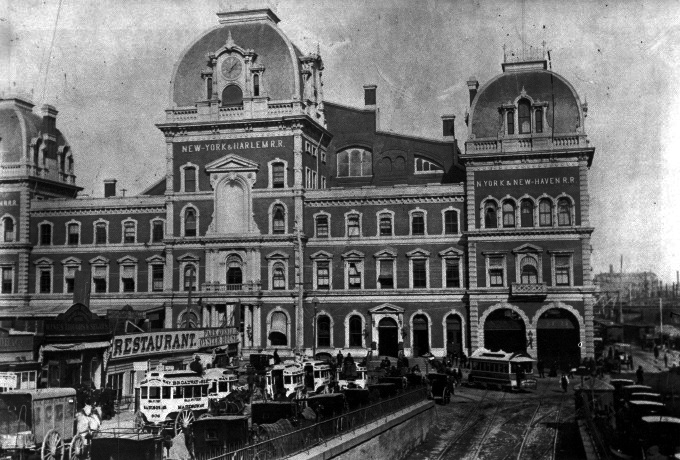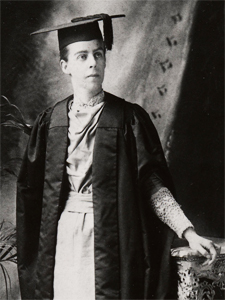In the Big City Book Club chat with Caleb Carr this time last year, one reader commented that they had not been aware that the Grand Central Depot had been the precursor to the Grand Central Terminal as New York’s primary railway station. As I thought other readers may be interested to learn a little more of the history of this lost piece of New York history, I have now added a brief history of this early depot to the New York City locations page of the site, along with a venue visited by John More and Mary Palmer in the novel that also had railroad ties, Madison Square Garden (and was the site of a sensational murder in the early 20th century). A copy of the depot’s entry from the locations page has been included below.
Grand Central Depot
Address: 42nd Street and Park Avenue, New York, NY
Featured in The Alienist (see map)
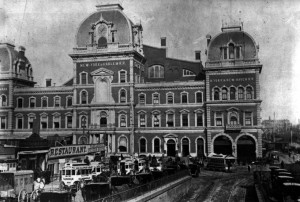 Within The Alienist, Dr. Kreizler and John Moore take a brief trip to Washington D.C. via a train departing from the Grand Central Depot to search for further clues about John Beecham’s life prior to his arrival in New York City. The precursor to New York’s current Grand Central Terminal, the Grand Central Depot was the largest train station in the country at the time it was built in 1871 by Cornelius Vanderbilt, and covered an area of 37 acres stretching between 42nd and 48th Streets, and from Lexington to Madison Avenues.1,2 At the time of the depot’s opening, 42nd Street was the northernmost edge of the city and took 45 minutes by trolley to travel to from the central business district.2 With rural homesteads and grazing animals visible across the street from the depot, critics complained that the new station was “neither grand nor central”.1 Nevertheless, 42nd Street was the closest point that the depot could be constructed due to a law passed in the mid-1850s forbidding passenger trains to pass any further into the city.1,2
Within The Alienist, Dr. Kreizler and John Moore take a brief trip to Washington D.C. via a train departing from the Grand Central Depot to search for further clues about John Beecham’s life prior to his arrival in New York City. The precursor to New York’s current Grand Central Terminal, the Grand Central Depot was the largest train station in the country at the time it was built in 1871 by Cornelius Vanderbilt, and covered an area of 37 acres stretching between 42nd and 48th Streets, and from Lexington to Madison Avenues.1,2 At the time of the depot’s opening, 42nd Street was the northernmost edge of the city and took 45 minutes by trolley to travel to from the central business district.2 With rural homesteads and grazing animals visible across the street from the depot, critics complained that the new station was “neither grand nor central”.1 Nevertheless, 42nd Street was the closest point that the depot could be constructed due to a law passed in the mid-1850s forbidding passenger trains to pass any further into the city.1,2
The station proper, an attractive French Second Empire style building designed by John B. Snook, serviced the three major rail lines in New York at the time — the New York Central and Hudson River Railroad, the New York and Harlem Railroad, and the New York, New Haven, and Hartford Railroad — with each maintaining their own waiting, baggage, and ticketing facilities in three separate towers of the building. Mansard caps topped each tower and displayed the name of the train line on their upper facades.2 Located behind the L-shaped station proper was an immense train shed more than 652 feet long that became the second most popular tourist attraction in the United States. Inspired by London’s Paddington Station, this engineering marvel, with an arched glass and wrought iron ceiling 112 feet high, contained 12 tracks separated by raised platforms. At night the glass ceiling was illuminated by gas lamps, giving the structure an otherworldly glow.1,2
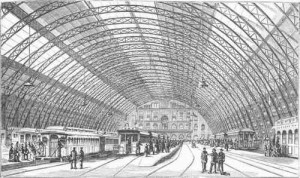 Even though the impressive depot had cost $6.4 million to build2, the design was not without its problems. The large number trains that used the station (up to 85 per day) could only exit in reverse, and the open tracks that ran northward from the depot were a death trap for anyone attempting to cross them. Even when footbridges were built, the steam from the trains made the area noisy, chaotic, and dangerous.1 Given the problems with its original design, the decision was made to lower many of the tracks below street level, first with a deeply cut roofed over and then with a multistory tunnel that ran from 96th Street and fanned into 41 tracks on the upper level at 57th Street, and 26 tracks on the lower level.3 The station proper also underwent renovations in 1898 to accommodate the now 1.5 million commuters using the depot daily. Three floors were added to the 42nd Street frontage, and the three towers were changed from Second Empire style mansard caps to a French Renaissance style design.2
Even though the impressive depot had cost $6.4 million to build2, the design was not without its problems. The large number trains that used the station (up to 85 per day) could only exit in reverse, and the open tracks that ran northward from the depot were a death trap for anyone attempting to cross them. Even when footbridges were built, the steam from the trains made the area noisy, chaotic, and dangerous.1 Given the problems with its original design, the decision was made to lower many of the tracks below street level, first with a deeply cut roofed over and then with a multistory tunnel that ran from 96th Street and fanned into 41 tracks on the upper level at 57th Street, and 26 tracks on the lower level.3 The station proper also underwent renovations in 1898 to accommodate the now 1.5 million commuters using the depot daily. Three floors were added to the 42nd Street frontage, and the three towers were changed from Second Empire style mansard caps to a French Renaissance style design.2
Even with the 1898 renovation, the facilities offered by depot were considered inadequate to the demands of the ever-expanding city. Customer service was poor and crime within the station was high.4 Moreover, although the lowering of the tracks had eliminated the problems associated with the original open tracks, they had created an even deadlier problem: the smoke-filled tunnels had extremely poor visibility.1,2 In 1891, the first head-on collision of commuter trains took place, resulting in passengers being trapped and burnt alive under the wreckage.4 When the tragedy was repeated in 1902, with a passenger train from New Rochelle crashing full-speed into a stopped train from Connecticut, the city put forth a requirement that all tracks become electrified.1,2 This was the final straw for the outdated depot, and a proposal to build a new $35 million station in the depot’s place was advanced that completely separated pedestrian, train, subway, and automobile traffic.1,3
Eleven years later, New York’s current Grand Central Terminal was opened in the original depot’s place. Although Cornelius Vanderbilt did not live to see the new magnificent Beaux Arts station, the Vanderbilt family retained control over the railroad until the 1950s when preservationists prevented the family from demolishing the terminal.2
References
1. Reiss, Marcia, “Lost New York” 2011.
2. Miller, Tom, “Daytonian in Manhattan: The Lost 1871 Grand Central Depot — 42nd Street” 4 Feb. 2013. Link.
3. Jackson, Kenneth T., “The Encyclopedia of New York City” 1995.

